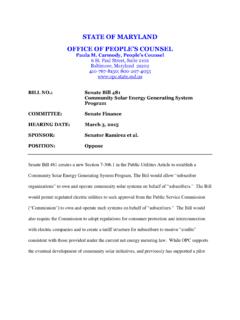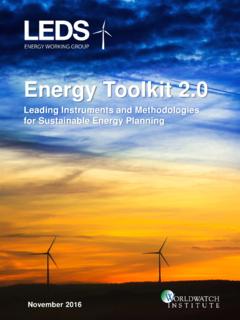Transcription of Renewable Portfolio Standards - US EPA
1 EPA Energy and Environment Guide to Action Renewable Portfolio Standards Policy Description and Objective Summary A Renewable Portfolio standard (RPS) requires electric utilities and other retail electric providers to supply a specified minimum percentage (or absolute amount) of customer demand with eligible sources of Renewable electricity. As of March 2015, 29 states and Washington, have established mandatory RPS requirements. An additional eight states have adopted non-binding Renewable Portfolio goals (DSIRE 2015d). In 2013, state RPS policies applied to 56 percent of all retail electricity sales (LBNL 2014). Between 1998 and 2013, 61 percent, or 46 gigawatts, of new, non-hydro42 Renewable energy capacity developed was added in states with existing or pending RPS requirements.
2 While this information is an imperfect metric, it indicates that RPS policies are a key driver for new Renewable electric generation facility development in the United States (LBNL 2013). Figure : Cumulative and Annual Non-hydro Renewable Energy Capacity in RPS and Non-RPS States, Nationally Source: LBNL 2014 RPS policies have supported the installation of new wind capacity, which accounted for approximately 78 percent of RPS-motivated Renewable energy capacity additions between 1998 and 2012. In recent years, RPSs have also increasingly supported the development of new solar capacity, particularly distributed generation (DG) such as customer-sited solar Seventeen states and Washington, , now include solar or DG-specific targets (also referred to as set-asides or carve-outs ) in their RPS requirements. Outside of California, solar and DG RPS policies drove approximately 60 to 80 percent of all new solar photovoltaic 42 Hydropower has historically been the dominant source of Renewable energy and there are many hydropower projects across the country.
3 Therefore, when discussing growth in the renewables sector, emphasis is typically given to non-hydro renewables. 43 DG, also called onsite generation, refers to small-scale, electric-generating technologies installed at, or in close proximity to, the end-user s location. Chapter 5. Renewable Portfolio Standards 5-1 Figure : Renewable Energy Certificates Illustrated EPA Energy and Environment Guide to Action (PV) additions since 2005 (LBNL 2014). In some states, RPSs have also supported the development of other Renewable sources such as solar thermal electric power, geothermal, and hydropower. Many states have adopted RPS requirements because they are an administratively efficient, cost-effective, market-based approach to achieving Renewable electricity policy objectives.
4 RPS requirements can be used in both regulated and restructured electricity markets. States have tailored their RPS requirements to satisfy particular state policy objectives, electricity market characteristics, and Renewable resource potential. Consequently, there is wide variation in RPS rules from state to state regarding the minimum requirement of Renewable energy, implementation timing, eligible technologies and resources, and other policy design details. An electricity supplier demonstrates compliance with RPS requirements by one of these three mechanisms: Own a Renewable energy facility and retain its Renewable electricity, including the Renewable energy certificates (RECs). Purchase electricity and RECs from a Renewable facility (sometimes called Renewable electricity or bundled Renewable electricity). Purchase RECs only (sometimes called unbundled RECs). A REC is a tradable right (separate from the electrical energy itself) to the environmental, social, and other generator attributes associated with 1 megawatt-hour (MWh) of Renewable electricity generated by a specific facility.
5 These attributes convey information about the generator, such as: type of resource ( , wind), plant-level air emissions (if any), geographic location, nameplate capacity (megawatt [MW]), commercial operation date, ownership, and eligibility for RPS compliance or voluntary market certification. A REC is the basis for demonstrating Renewable electricity ownership, procurement, use, and compliance (CRS 2014). Unlike procuring Renewable electricity (bundled electricity and RECs), REC-only transactions are not constrained by the physical delivery of electricity over the power grid. They can therefore be traded between two parties regardless of the location of the generator relative to the utility seeking compliance under an RPS. State RPSs typically limit the eligibility of RECs based on either the location of the generating facility or whether it sells power to the state or to the regional grid.
6 As of January 2014, 35 states and territories allow RECs to satisfy either mandatory RPS requirements or voluntary Renewable Portfolio goals (CRS 2014). Source: DOE and EPA 2010 5-2 Chapter 5. Renewable Portfolio Standards EPA Energy and Environment Guide to Action Objective States create RPS programs because of the energy, environmental, and economic benefits of Renewable energy. Many states have also adopted RPS programs to stimulate market and technology development and to ultimately help make Renewable energy competitive with conventional forms of electric power. Benefits RPS benefits are the same as those from Renewable energy in general: Environmental improvement ( , less air and carbon pollution, climate change mitigation, waste reduction, habitat preservation, conservation of water and other valuable natural resources).
7 Increased diversity and security of energy supply, with greater reliance on domestic, regional, and in-state resources. Reduced volatility of power prices given the stable (or nonexistent) fuel costs of renewables. Local economic development resulting from new jobs, taxes, and revenue associated with new Renewable capacity (NREL and LBNL 2014). An RPS can function in both traditionally regulated and competitive state electricity markets. Furthermore, states often find that RPS requirements provide a cost-effective approach to achieving energy and environmental goals. Because RPS compliance is market-based, an RPS typically leads to development of the most cost-competitive forms of Renewable energy (currently wind power in most cases), unless the RPS includes features that also encourage higher cost Renewable technologies. Finally, because it is market-based, an RPS can achieve its policy objectives efficiently and with relatively modest impacts on customer bills.
8 States with RPS Requirements Tremendous diversity exists among state RPSs with respect to the minimum requirements of Renewable energy and implementation timing (see Tables and ), as well as eligible technologies and resources. Although no new states have enacted RPS requirements since 2009, states with existing RPS policies have continued to refine their rules to reflect new technology, resource, and policy considerations that have changed over time. Between 2007 and 2013, 24 states passed major revisions to existing RPS policies. For example, 11 states have added solar and/or DG set-aside requirements since 2007 (LBNL 2013). Many of the early RPS laws emerged as part of state deregulation of the electricity sector. However, states that are not deregulated have adopted RPS requirements while addressing other policy concerns, such as rising natural gas and coal prices or climate change.
9 To date, 13 states and Washington, , have enacted RPS requirements as part of restructuring legislation,44 and 16 states have enacted RPS requirements under traditional utility regulation (NREL and LBNL 2014). 44 A restructured market is defined here as one in which the traditional electric utility monopoly, where the utility provides generation, transmission, and distribution, has been split. Customers in restructured states can choose which electric service company will supply their generation. The following states are thus counted as operating in restructured markets: Connecticut, Delaware, Illinois, Massachusetts, Maryland, Maine, New Hampshire, New Jersey, New York, Ohio, Pennsylvania, Rhode Island, Texas, and Washington, (NREL and LBNL 2014). Chapter 5. Renewable Portfolio Standards 5-3 EPA Energy and Environment Guide to Action Table : Mandatory State RPS Requirements State Main Target Solar or DG* Target AZ 15% by 2025 customer-sited DG by 2025 (half from residential) CA 33% by 2020 CO 30% by 2020 (IOUs) 10% by 2020 (co-ops and large munis) IOUs: 3% of the 2020 requirement DG by 2020 (half customer-sited) Co-ops: to 1% DG by 2020 (depending on size) Various credit multipliers available CT 27% by 2020 IOUs must solicit 15-year contracts for ZRECs and LRECs from customer-sited facilities of up to 1 MW (ZRECs) and 2 MW (LRECs), within certain annual budgets.
10 DC 20% by 2020 solar by 2023 DE 25% by 2026 solar by 2025, 3x multiplier for solar installed before Jan. 2015 HI 40% by 2030 IA 105 MW IL 25% by 2025 solar PV by 2025 1% DG by 2015 (50% <25kW) KS 20% by 2020 MA by 2020 New Renewable energy: 15% by 2020 (+1%/year after) 1,600 MW by 2020 MD 20% by 2022 2% solar by 2020 ME 30% by 2000 New Renewable energy: 10% by 2017 MI 10% and 1,100MW by 2015 3x multiplier for solar MN 25% by 2025 (Xcel: by 2020) solar by 2020 (IOUs) MO 15% by 2021 solar electric by 2021 MT 15% by 2015 NC by 2021 (IOUs) 10% by 2018 (co-ops & munis) solar by 2018 NH % by 2025 solar electric by 2014 NJ by 2021 solar electric by 2027 NM 20% by 2020 (IOUs), 10% by 2020 (co-ops) 4% solar electric by 2020, customer-sited DG by 2020 NV 25% by 2025 solar by 2025, multiplier for PV until 2015 5-4 Chapter 5. Renewable Portfolio Standards EPA Energy and Environment Guide to Action Table : Mandatory State RPS Requirements State Main Target Solar or DG* Target NY 29% by 2015 customer-sited by 2015 OH by 2026 solar electric by 2026 OR 25% by 2025 (large utilities) 5-10% by 2025 (smaller utilities) 20 MW solar PV by 2020 2x multiplier for PV installed before 2016 PA 18% alternative energy by 2021 solar PV by 2020 RI 16% by 2020 TX 5,880 MW by 2015 2x multiplier for all non-wind WA 15% by 2020 2x multiplier for DG WI ~10% by 2015 (varies by utility) Co-op= cooperatively owned utility; GWh= gigawatt-hour; IOU= investor-owned utility; kW= kilowatt; LREC= low emission Renewable energy certificate; munis= municipally owned utility; MW= megawatt; Xcel=Xcel Energy.














